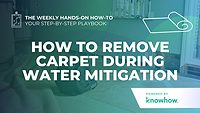Weekly Hands-on How-To powered by KnowHow
How to Lift Carpet and Pull Pad/Tack Strip

When a homeowner wakes up and heads to the basement only to step onto a carpet that feels like they're walking on a drenched sponge, they know there's a problem. Whether the water damage is small or extensive, it often means the carpet is at risk of developing mold, warping, or other long-term damage that requires immediate attention.
If the water damage cannot be mitigated by wet vacuums and cleaning, it's time to remove the damaged carpet and make way for restoration experts. This weekly how-to, powered by KnowHow, will guide you through the steps to properly lift the carpet and remove the pad without causing damage. From gathering the right tools to safely removing tack strips, these best practices will ensure you can tackle the job efficiently and effectively.
Let’s tear up this carpet (hopefully, it’s shag) and walk through the steps to start revitalizing your client’s homes after a water loss!
Note: This Weekly Hands-On How-To was based on this template in KnowHow’s template library.
Step 1: Gather Required Tools
Before you begin, make sure you have all the necessary tools at hand. Being well-prepared with the right tools not only makes the task more manageable but you also don’t have to go back to the office or call a coworker if you’re missing something. Gather the following items:
- Shovel
- Floor scraper
- Hammer
- Pry bar
- Pliers
- Utility knife
- Heavy work gloves
- 5-in-1 tool
- 3 mil garbage bags
Tip: Avoid using a screwdriver, as it can break the tack strip and shear the wood.
Step 2: Assess and Prep the Affected Area
A thorough assessment and preparation of the affected area can help you work more safely and efficiently, minimizing any potential damage to the home or materials.
Start by walking through the area to evaluate the extent of the water damage and determine the best approach for moving forward. Here’s what you need to do:
- Move any furniture out of the way to clear the area.
- Place floor covering on the surrounding areas to protect them from damage.
These preparations will create a clean and safe workspace, allowing you to focus on the task at hand without unnecessary interruptions or risks.

Step 3: Work Safely
Safety should always be a top priority, especially when dealing with sharp tools and materials like carpet tack strips. Taking the appropriate safety measures ensures the process goes smoothly and prevents injuries. Here are some basic safety tips:
- First Aid Kit: Keep a first aid kit nearby, as it is common to poke your finger with the tack strip.
- Heavy Work Gloves: Wear heavy work gloves to protect your hands from the sharp tack strip.
- Garbage Bags: Use 3 mil or thicker garbage bags to ensure no tears or rips and to dispose of the tack strips safely.
- Work Boots: Wear work boots to protect your feet from nails and staples.
Step 4: Pull Carpet Back
Now that you're prepared and have a safe working environment, it's time to start pulling the carpet back! This step requires careful handling to avoid damaging the carpet, especially if it can be reinstalled later.
- Begin in a corner and try to pinch the carpet to see if it will pull up easily.
- If it doesn't come up easily, use pliers to grab the carpet fibers in the corner and pull just enough to switch to using your hand.
- Slowly pull the carpet back off the tack strip.
- Loosely fold the carpet back to expose the affected pad area for removal.
Tip: Be careful not to let the carpet hit the wall, as it can scratch the paint. If needed, use a carpet knee kicker to loosen the carpet.
Step 5: Remove Carpet Pad
With the carpet pulled back, the next step is to remove the carpet pad. This involves careful cutting and handling to ensure a clean removal without leaving behind any residue.
- Use a utility knife to score (cut) the pad where you want it removed.
- Pull the carpet pad back and discard it.
- On wood subfloors, use a pry bar, screwdriver, or pliers to remove any staples and discard the remaining pad stuck under the staples.
- On concrete floors, use a floor scraper to remove the pad held by glue.
Step 6: Remove Tack Strip
Once the carpet pad is removed, safely remove the tack strip to prevent any injuries and prepare the area for new flooring if needed. This step is usually where most workplace injuries related to carpet removal occur, so watch out for all the nails and tacks!
- Use a hammer and pry bar to lift the nails holding the tack strip and pull up to remove it.
- Start by pulling up where the nails attach the strip to the floor, typically every 6 inches.
- The goal is to pull the tack strips up in one piece rather than breaking them into small pieces.
- For larger areas, you can use a shovel to help lift the tack strip, but be careful not to hit the walls.
Extra Tips for Concrete Surfaces
- To remove nails, tap and jiggle the pry bar or hammer under the nails to leverage and pull them up.
- If dealing with glue-down tack strips, try using a 5-in-1 tool wrapped in a cloth towel to scrape off the residue. The towel will help protect the tile surface.
Keep the tack strips in a pile and carefully place them in a garbage bag one piece at a time to avoid cutting yourself.
You Lifted the Carpet; Now Let's Lift Your Business
So there you go, another "tool" in your restoration belt. Practice this on a couple of job sites, and you'll be an expert in no time. Or will you? The reality is that restoration brings so many different challenges and processes to memorize, so you never know when you'll do this next! If you only do this once every couple of months, you are bound to have questions or need reminders on the next go-around.
Unfortunately, these questions typically go to your crew chief or manager. While these questions do need to be answered, addressing them takes time away from their schedules that could be better spent on solving bigger problems for the team. This is where KnowHow shines. KnowHow’s desktop and mobile application provides restorers with instant, on-the-job support so you and your team can get answers right when they need them without diverting your senior staff from critical tasks.
Lift up your business with KnowHow. Visit us at tryknowhow.com to learn more and see how KnowHow streamlines operations, ensuring restorers always have instant access to the information they need.
Looking for a reprint of this article?
From high-res PDFs to custom plaques, order your copy today!








